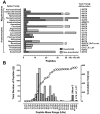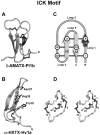Spider-venom peptides as bioinsecticides
- PMID: 22741062
- PMCID: PMC3381931
- DOI: 10.3390/toxins4030191
Spider-venom peptides as bioinsecticides
Abstract
Over 10,000 arthropod species are currently considered to be pest organisms. They are estimated to contribute to the destruction of ~14% of the world's annual crop production and transmit many pathogens. Presently, arthropod pests of agricultural and health significance are controlled predominantly through the use of chemical insecticides. Unfortunately, the widespread use of these agrochemicals has resulted in genetic selection pressure that has led to the development of insecticide-resistant arthropods, as well as concerns over human health and the environment. Bioinsecticides represent a new generation of insecticides that utilise organisms or their derivatives (e.g., transgenic plants, recombinant baculoviruses, toxin-fusion proteins and peptidomimetics) and show promise as environmentally-friendly alternatives to conventional agrochemicals. Spider-venom peptides are now being investigated as potential sources of bioinsecticides. With an estimated 100,000 species, spiders are one of the most successful arthropod predators. Their venom has proven to be a rich source of hyperstable insecticidal mini-proteins that cause insect paralysis or lethality through the modulation of ion channels, receptors and enzymes. Many newly characterized insecticidal spider toxins target novel sites in insects. Here we review the structure and pharmacology of these toxins and discuss the potential of this vast peptide library for the discovery of novel bioinsecticides.
Keywords: bioinsecticides; cystine knot; insecticidal; peptide; pest control; spider venom.
Figures




Similar articles
-
Versatile spider venom peptides and their medical and agricultural applications.Toxicon. 2019 Feb;158:109-126. doi: 10.1016/j.toxicon.2018.11.298. Epub 2018 Dec 11. Toxicon. 2019. PMID: 30543821 Review.
-
Spider-venom peptides: structure, pharmacology, and potential for control of insect pests.Annu Rev Entomol. 2013;58:475-96. doi: 10.1146/annurev-ento-120811-153650. Epub 2012 Sep 27. Annu Rev Entomol. 2013. PMID: 23020618 Review.
-
Tying pest insects in knots: the deployment of spider-venom-derived knottins as bioinsecticides.Pest Manag Sci. 2019 Sep;75(9):2437-2445. doi: 10.1002/ps.5452. Epub 2019 May 31. Pest Manag Sci. 2019. PMID: 31025461 Review.
-
An insecticidal toxin from Nephila clavata spider venom.Amino Acids. 2017 Jul;49(7):1237-1245. doi: 10.1007/s00726-017-2425-2. Epub 2017 May 11. Amino Acids. 2017. PMID: 28497266
-
Genetically encoded libraries and spider venoms as emerging sources for crop protective peptides.J Pept Sci. 2024 Sep;30(9):e3600. doi: 10.1002/psc.3600. Epub 2024 Apr 16. J Pept Sci. 2024. PMID: 38623834 Review.
Cited by
-
The insecticidal potential of venom peptides.Cell Mol Life Sci. 2013 Oct;70(19):3665-93. doi: 10.1007/s00018-013-1315-3. Epub 2013 Mar 23. Cell Mol Life Sci. 2013. PMID: 23525661 Free PMC article. Review.
-
Molecular basis of the remarkable species selectivity of an insecticidal sodium channel toxin from the African spider Augacephalus ezendami.Sci Rep. 2016 Jul 7;6:29538. doi: 10.1038/srep29538. Sci Rep. 2016. PMID: 27383378 Free PMC article.
-
Strategies for Heterologous Expression, Synthesis, and Purification of Animal Venom Toxins.Front Bioeng Biotechnol. 2022 Jan 20;9:811905. doi: 10.3389/fbioe.2021.811905. eCollection 2021. Front Bioeng Biotechnol. 2022. PMID: 35127675 Free PMC article. Review.
-
De Novo Transcriptome Analysis of the Venom of Latrodectus geometricus with the Discovery of an Insect-Selective Na Channel Modulator.Molecules. 2021 Dec 22;27(1):47. doi: 10.3390/molecules27010047. Molecules. 2021. PMID: 35011282 Free PMC article.
-
Common Virulence Factors and Tissue Targets of Entomopathogenic Bacteria for Biological Control of Lepidopteran Pests.Insects. 2014 Jan 6;5(1):139-66. doi: 10.3390/insects5010139. Insects. 2014. PMID: 24634779 Free PMC article.
References
-
- Ødegaard F. How many species of arthropods? Erwin’s estimate revised. Biol. J. Linn. Soc. 2000;71:583–597. doi: 10.1111/j.1095-8312.2000.tb01279.x. - DOI
-
- Pimentel D. Pesticides and pest control. In: Peshin R., Dhawan A.K., editors. Integrated Pest Management: Innovation-Development Process. Vol. 1. Springer Verlag; Dordrecht, The Netherland: 2009. pp. 83–87.
-
- Oerke E., Dehne H. Safeguarding production-losses in major crops and the role of crop protection. Crop Prot. 2004;23:275–285.
-
- Novotny V., Basset Y., Miller S.E., Weiblen G.D., Bremer B., Cizek L., Drozd P. Low host specificity of herbivorous insects in a tropical forest. Nature. 2002;416:841–844. - PubMed
Publication types
MeSH terms
Substances
LinkOut - more resources
Full Text Sources
Other Literature Sources

